Content distribution is the art of promoting, sharing and repurposing your content to reach more people.
It can easily double or even 10x the ROI from your content marketing. Letting you get more value from fewer pieces of content.
And it’s exactly what this new guide covers.
Read on for the full step-by-step walkthrough, or jump straight to part 3 below for a proven list of specific content distribution ideas.
Contents
Part 1: How to Create a Content Distribution Strategy
Part 2: The 3 Major Content Distribution Channels
Part 3: Specific Content Distribution Ideas: 28 Tactics and Tools
Part 1: How to Create a Content Distribution Strategy
Step 1: Choose a goal for your content.
What are you trying to get out of your content marketing?
What would “success” look like?
Different distribution techniques lead to different results. So it’s important to answer those questions before you create your content distribution strategy.
The best goals are S.M.A.R.T.:
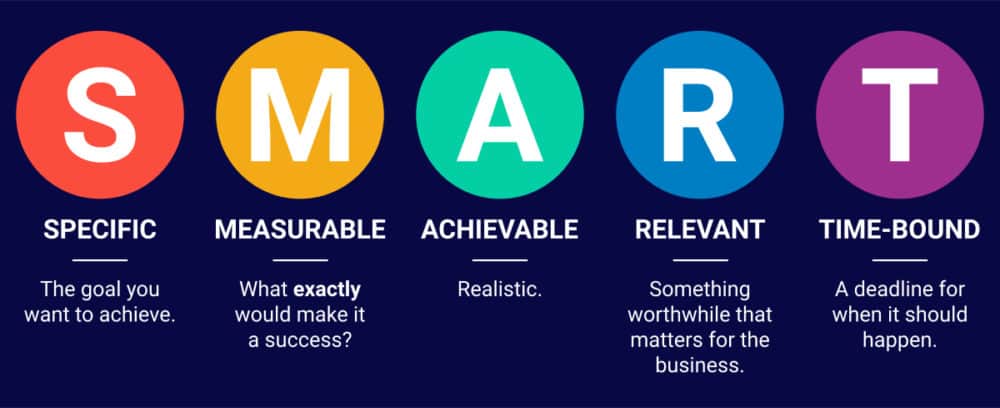
That said, I have a contrarian view on goal-setting.
If this isn’t your first rodeo, then it pays to get specific.
But if this is the first time you’ve made a deliberate content distribution plan?
In that case, it’s better not to set super specific goals.
Because you can’t know what to expect your first time. So getting too granular will only slow you down.
In any case, you should at least think about what types of results you’re after.
Here are some to consider:
Brand visibility: search lift, press coverage, social mentions, social followers.
Traffic: site visits, key page views, new visitors.
Email: newsletter signups, lead magnet downloads.
SEO: backlinks, keyword rankings, organic search traffic.
Lead generation: lead form submissions, inbound calls and emails, case study views.
User acquisition and retention: user signups, MAUs, reduced churn.
Sales and revenue: transactions, revenue, new customers.
Choose one or two and move on.
Step 2: Decide who you want to reach.
The next step is thinking about who will help you reach those goals. So that you can reach them where they hang out online.
If your main goal is to drive product sales or leads, the answer is simple:
Whoever your target customer is.
Whereas if you’re looking for press coverage, you’ll need to find who the journalists are that cover your space. (BuzzSumo is great for that.)
Step 3: Find the best content distribution channels to reach your target audience.
Now that you’re clear on the people you’re trying to reach, it’s time to figure out the best ways to reach them.
Here are 3 ways to figure that out.
Method #1 is with Google Analytics.
This is a great method if your goal is to get more subscribers, users, leads or paying customers. In other words, if you want to reach more of the types of people who already come to your site.
(It won’t work as well for finding influencers or journalists.)
Basically, you just need to find out where your best traffic is already coming from. And then promote your content in those places.
Here’s how to do it.
In Google Analytics, go to Acquisition >> All Traffic >> Source/Medium.

The report on the right will show your top traffic sources. Scroll further to the right and you’ll see any conversions that you’re getting from them.
As you can see, two of my top traffic sources are Google and Reddit:

That tells me that people on Reddit seem to like my content. And that it’s also working from an SEO perspective.
From this point, you can investigate any specific traffic sources you find.
For example, if you have lots of leads coming from Twitter, go look at your top-performing Twitter posts to see what’s been working.
Or type your domain into the search bar to see who else is linking to your site and why.

Since Reddit seems to be working for me, I want to find the posts that are linking to my site.
You can find any Reddit posts about your brand by searching Google for “site:reddit.com [yourdomain.com]” or “site:reddit.com [your brand name]”.

Now you can focus your content distribution strategy around the traffic sources that are already working.
Method #2 is to spy on your competitors using SimilarWeb.
Over at similarweb.com, type in a competitor’s URL.

Tip: Not sure which competitors to look at? Just Google your topic or “[your topic] blog”.
Now hit “search” and SimilarWeb will pull up an overview of your competitor’s website.
Finally, click “Referrals” on the left to see the top sites that are sending traffic to your competitor. Those are all potential places to distribute your content.

(Bonus: while you’re at it, SimilarWeb can show you your competitor’s top search keywords as well. Just click the “Search” button on the left.)
And method #3 is to use SparkToro.
SparkToro lets you see where your audience spends time online.
Like:
The social accounts they follow and engage with.
The websites they visit, share and link to.
The podcasts they listen to.
The YouTube channels they subscribe to.
And more.
To use the tool, first go to SparkToro.com.
Then type in your industry or a related subject your audience cares about, like “scuba diving” or “financial independence.” And hit Search.
SparkToro will generate a report about the people who are interested in that subject.
Click on the options on the left-hand side to see each aspect.

Now you should have some ideas on how to reach the people who are interested in your industry or content.
Try to come up with a few different content distribution ideas or channels that look promising.
But don’t worry about making a super long list at this point.
We’ll cover lots more content distribution tactics a little later in this guide.
Step 4: Match your message to the medium.
The point of content distribution is to make your content marketing resonate with more people.
But here’s the key:
When you share your content, don’t make it look like marketing.
Spamming links to your content across every social network and forum you find just doesn’t work.
Instead, use each platform the way it’s meant to be used.
Look at what’s already performing well there. How do people structure their posts? How do they phrase them to avoid seeming self-promotional?
Here’s a recipe that often works:
Provide a useful snippet or summary of your key points, followed by a link back to the source content.
That way you’ll get plenty of upvotes, likes, shares or comments. While still driving traffic back to your main content.
One great example is this Twitter thread by Basak Anil from Apparent.
She started the thread with a brief summary:

Then she laid out an in-depth, interesting thread — the kind people love to retweet:

After that, Basak ended the thread with a link back to her original article…

And finally, she responded to every reply. Which made those commenters more likely to retweet, click through to her site, and subscribe.

Step 5: Repurpose content.
Repurposing content lets you get 2 or more times as much value from each piece you produce.
In fact, repurposing your content is so important that it has practically become synonymous with content distribution.

As Ross’s tweet says, examples of content repurposing include:
- Podcasts >> tweets
- Blog posts >> Twitter threads (like the example from Basak above)
- Podcasts >> social videos
- And white papers >> Instagram carousels.
Of course, there are lots of other possibilities. We’ll cover many of them in detail in the Content Distribution Ideas section below.
But in general, it’s a good idea to repurpose each piece of content at least once or twice.
Part 2: The 3 Major Content Distribution Channels
There are lots of ways to distribute and promote your content.
And each one takes a different approach.
For example, to succeed with SEO requires a different approach from paid advertising.
And a social media campaign is a lot different from sending an email to your newsletter subscribers.
But “zoom out” a little and you’ll see patterns.
In fact, there are three overarching content distribution channels:
OWNED media consists of properties you directly control. Like your blog, podcast or YouTube channel.
Owned media is free. And it’s usually highly targeted. It’s great for turning leads into customers, deepening relationships with existing customers, and getting repeat sales.
But used alone, owned media doesn’t have much reach. That’s because you’re kind of “preaching to the converted.”
To grow your business with content marketing, you need to reach beyond the people who already know you.
EARNED media is the exposure you earn — mostly by producing interesting work. Examples include press coverage, SEO traffic and shares on social media.
You don’t have direct control over earned media.
But it brings in a larger audience than owned media does. And it’s still free (with effort).
Plus, a Nielsen study found that earned media is the most trusted type of media worldwide.
PAID media is the distribution you pay for. Like Facebook ads, sponsored content and most influencer marketing.
You generally have direct control over paid media: you write the ad and choose who sees it.
And like earned media, paid media will let you reach people you haven’t before.
But of course, paid media’s downside is that it costs money.
Different paid media channels also require specific expertise in those platforms. Which makes them harder to use for indie entrepreneurs and solo content marketers.
So which content marketing distribution channel is the best?
I recommend working from the top down.
You should always use owned media, since it’s free and simple to do.
Try to use earned media to extend the reach of any major pieces of content. (See my guide to content optimization for help with that.)
And paid media is a great way to add fuel to the fire once you have an effective content marketing funnel in place. But until then, it’s usually not worth it.
So those are the 3 overarching content distribution channels.
Now let’s get specific.
Below are dozens of individual tactics you can use to distribute your content.
Part 3: Content Distribution Ideas (Tactics and Tools)
We’ve covered all the basics of content distribution.
Now let’s look at some proven, specific tactics and tools for distributing your content.
Reddit Content Marketing
Did you know that Reddit gets more than 50 billion monthly pageviews on its 100k+ active communities?
It’s one of the 10 most popular websites in the United States.
And it’s a great place to distribute content.
In fact, I’ve used Reddit to drive tens of thousands of visits to this blog. Here are some of my top posts there:

So Reddit is a great opportunity. But it’s also tricky.
Reddit users are super skeptical.
In fact, redditors hate marketers. At least the spammy ones.
But I’m a marketer, and I’ve made top-ranked posts on the competitive r/Entrepreneur subreddit more than once.
How?
By providing real value on Reddit itself. Not just a link to my content.
I do that by posting an in-depth summary of my content’s key takeaways.
Here’s an example:

Notice the sentence at the bottom. It links back to my article, along with the reasons they should check it out.
Another key to Reddit is:
Choose your subreddits wisely.
You want to post in subreddits that are active enough to be worth your time, of course. But they also need to be relevant to your content.
I’ve had the best luck with r/Entrepreneur and r/Blogging. Which makes sense because I write about growth strategies, and everyone in those subreddits wants to either grow their business or grow their blog.
To find a subreddit, search Google for “reddit [subject]” or “reddit [industry]” or “reddit [product]”:

It also helps to actively participate in any relevant subreddits before posting in them. Get to know their shorthand and common references, and what they like and don’t like.
That way you can easily respond to any comments on your own posts. And members will see that you’re not just dropping in to spam.
So to sum up, the keys to promoting your content on Reddit are:
- Write a value-packed summary of your work. Not just a link.
- Post it in relevant, active subreddits.
- Establish yourself in those subreddits first, and respond to commenters so you won’t seem like a spammer.
Facebook Groups and Other Communities and Forums
More than 1.8 billion people use Facebook Groups to discuss different topics — and to share content about those topics. So no matter who your customers are, you can bet they’re in at least one Facebook Group.
It’s a little more saturated with marketers than Reddit is, but it’s also a massive opportunity.
But there are also tons of independent communities and forums.
For example:
Bodybuilders have the Bodybuilding.com forums, with hundreds of millions of posts.
Gamers have GameFAQs and Gaia Online.
Investors have BogleHeads and BiggerPockets.
And entrepreneurs have Indie Hackers and Product Hunt Discussions.
To find communities in your niche, just search Google for “[subject] community” or “[subject] message board” or “[subject] forum”.

Join the most active communities. But don’t spam them!
Instead:
- Interact and answer questions
- Add real value in discussions
- Follow the community rules
- Play it cool 😎
And occasionally sprinkle in your own content here and there, when it’s truly helpful.
You can also sponsor many communities. Guaranteeing consistent exposure to their members.
Just reach out to the site owner/administrator and ask what advertising opportunities are available. Or in the case of Facebook and Reddit, use those platforms’ advertising tools directly.
Point Facebook Ads at Your Best Content
One of the best things about content marketing is that it doesn’t require any budget to get started.
But if you do have a budget, spending a little money on paid advertising is an excellent way to increase your results. Facebook Ads are particularly great at driving relevant top-of-funnel traffic.
Let’s say you have a great case study about your SaaS.
You can use Facebook Ads to send targeted traffic to that case study. Then collect email addresses from visitors using a lead magnet. And finally, sell to those people via a drip email sequence.
Here’s a more concrete example.
HubSpot is running the following ad on Facebook right now. As you can see, it calls out their free marketing guides:

When you click through the ad, you land on this page of free PDF guides, tools and other lead magnets:

Click on one and you’re prompted to fill out a lead form. And to join HubSpot’s mailing list.

From there, HubSpot’s drip email sequence will gradually work on converting you into a paying customer.
Nicely done, HubSpot.
Here are some more tips for using Facebook Ads for content distribution:
- Spy on your competitors. The Facebook Ad Library is incredible. It lets you see every ad that’s currently live on Facebook or Instagram. Just type in a competitor’s name, select their page and spy away.
- Use lookalike audiences. 1% Facebook lookalike audiences almost offer the best bang-for-your-buck targeting. Create your lookalike audience using your list of email subscribers. Or better yet, use your list of actual paying customers.
- Spend enough money to get out of the learning phase. Otherwise Facebook won’t be able to optimize your ad set’s delivery, and it will underperform.
Usually you’ll need to spend around $100 per day in order to exit the learning phase. But it depends how many conversions you get.
- Refresh your ad creative on a regular basis. For any given ad, your cost per acquisition will increase over time. That’s because they get stale and people start ignoring them. So change your ad creative whenever your results start to suffer. (Dynamic Creative ads help!)
- Set up multiple campaigns and ad sets. Create at least two campaigns: one for your “proven” ad sets and one for any new creatives and targeting you’re testing.
That way, you can use campaign budget optimization for your proven campaign. While always testing new ad sets with fresh creatives in your testing campaign.
- Create your sales funnel first. If you don’t have a proven way to turn traffic into revenue, I wouldn’t use any paid advertising yet. Because it will just waste your money.
In other words, paid content distribution works best for pouring gasoline on a fire — not sparking one from nothing.
Use the Double Survey Technique
The Double Survey Technique is a way to get more backlinks, social shares and traffic to your blog or website.
And let me tell you: it works like magic.
The first time I used this technique, I used it to create a blogging study.
That one post got shared by influencers with follower counts of over 1 million people on Twitter alone. (At a time when I only had about 100 followers myself.)
And it brought in links from hundreds of sites larger than this one.
Since then, I’ve used the same tactic to land coverage and links from huge sites like Forbes, HubSpot, Crunchbase, Moz and more.

In fact, links are still rolling in from content I published back in 2019.

Here’s how the Double Survey Technique works.
First, you create a data-driven piece of content. Usually by conducting a basic experiment or running a survey about your industry.
Then, you ask some influential experts in your niche for their opinions on your results.
Finally, publish your results along with quotes from the experts. And let them know you did.
Most of them will share your content with their audience, giving it the early momentum it needs to pick up steam.
You can see more details in my full Double Survey Technique guide.
Repurpose Industry Studies Into Press Releases, Blog Posts and More
Industry studies and whitepapers are often gated behind an email capture form. Other times, the full paper is too technical and in-depth for most people.
Either way, you can squeeze more value from your study by making a press release or blog post that summarizes the top insights.
Upwork’s annual “Freelancing in America” study is a great example of this tactic. In fact, they repurpose their annual study 4 different ways:
- In a quotable press release
- In a SlideShare deck
- In a high-resolution infographic
- In a full “economist’s report,” written by a PhD

As a result, Upwork’s last study earned links and coverage from over 1,500 sites including CNBC, Entrepreneur, Fast Company and more.
Post Micro-Snippets with Key Takeaways from Your Videos or Podcast
If you have a YouTube channel or podcast, pull out short clips from longer pieces to share on social media.
Here’s an example from Nathan Barry’s podcast.
His full interview with Jack Butcher lasted over an hour. But Nathan made several short, 2-minute excerpts and shared them on Twitter — each focused on a single premise or lesson. This one was about “the secret to a profitable online business”:

If you have an audio-only podcast, this is a bit harder because most social networks don’t let you share pure audio clips.
The solution:
Use Wavve or Descript Publishing to turn any audio clip into a waveform video. Then share the “audiogram” Instagram, Facebook, Twitter or elsewhere.
Be sure to add subtitles.
Break Long YouTube Videos Down Into Keyword-Targeted Clips
This tip is similar to the last one, but with a twist.
Do you publish interviews on your YouTube channel?
If so, you know they can be great for average view duration.
But there’s one problem: interviews usually don’t bring in much YouTube search traffic. (Unless someone searches specifically for “interview with ____”.)
The reason?
Most interviews cover tons of different subjects.
For example, let’s say you interviewed me about content marketing.
In the course of an hour, we might talk about how I built so many authoritative links to this website, the importance of building an email list, my content development, framework and more.
The video title for that interview isn’t going to cover every one of those topics. And someone who wants to learn about just one of them won’t want to watch an interview that covers lots of other subjects, either.
Which means that the full-length interview isn’t going to rank for keywords like “how to build authority links” or “content development strategies”. Even if those topics were covered.
Solution:
Create shorter, focused videos from the full interview to cover each of those subjects.
Tim Ferriss does this really well.
His recent interview with Ramit Sethi lasted 87 minutes and covered lots of different money-related subjects.

So he also created several focused, ~5-minute clips of the interview…

With a link back to the full-length interview in the video description of each clip.

Alternatively, you can post only the shorter clips to YouTube. And prompt viewers to visit your site for the full video.
That’s what Sam Jones does with his Off Camera channel. And Netflix does it too with Netflix Is A Joke.
Repurpose YouTube Videos Into Podcast Episodes (and Vice-Versa)
57% of Americans have listened to at least one podcast so far this year. That’s a massive audience that anyone should be excited to tap into.
The problem: creating new podcast episodes on a regular basis isn’t easy.
The solution:
If you already have a YouTube channel, consider whether your videos really need the visual component.
Most informational videos don’t. Which means you can simply take the audio from them and publish them as a podcast as well.
Fast-growing channels like Marie Forleo, Dave Lee and Marques Brownlee all publish their YouTube videos as podcasts.
If you already have a podcast but aren’t making videos, you can do the same thing in the opposite direction.
With over 2 billion monthly active users, YouTube is one of the best ways for podcasters to reach new people.
Lex Fridman, Tim Ferriss and Joe Rogan all started with an audio podcast and began also publishing it as a video podcast on YouTube. That content disribution strategy has brought them hundreds of millions of YouTube viewers in addition to their regular podcast listeners.
While smaller creators like Paula Pant don’t even shoot any footage. But they still rack up millions of additional listens by uploading audio-only podcast episodes to YouTube.

Re-Share Past Social Media Posts
Only a small fraction of your social followers will see what you post the first time around.
So why not post it again, later?
Arvid Kahl retweets his own years-old tweets on a regular basis.

While Pitchfork re-shares older articles with “ICYMI” (in case you missed it).

This is a great way to get more mileage out of your posts.
You can also use a tool like Later, Buffer or Meet Edgar to automate your re-posts.
Create SEO-Focused Content
Search engine optimization is a huge topic of its own. But at its core, SEO is a type of content distribution.
However, you can’t just slap it on after the fact.
Instead, it’s better to create content with SEO in mind from the start.
Here’s how:
1. Find a keyword to target.
Keyword research doesn’t have to be complicated. One quick way to do it: just type your topic into the Ahrefs Free Keyword Generator and hit “Find keywords.”

Look for something with a low keyword difficulty score, but a decent number of monthly searches.
The more relevant it is to your business, the better.
(Need more keyword ideas? I made a list of great free and paid keyword research tools here.)
2. Figure out the search intent behind your target keyword.
“Search intent” means what people actually want when they search for that keyword.
Are they looking for an in-depth review? A listicle? Or a product page?
The best way to figure out search intent is to simply search for the keyword on Google.
Look at patterns in the top 3-5 ranking pages. Like how they’re structured and what they cover.
Then use that as inspiration for your own article.
3. Create your content.
The most important thing about creating SEO content is to make it really, really good.
It’s not enough to make it as good as the top-ranking pages on Google. You have to make it even better.
For example:
- More clearly written.
- More actionable.
- More in-depth. (Or more concise, if that’s what Google is favoring for that keyword.)
- Better optimized for search intent.
- Better designed.
- More interesting, useful or emotionally resonant.
Finally, make sure you add internal links pointing to your new content from your old content. This is super important.
Find Missing Keywords with Google Search Console
Your best blog posts or articles will almost always end up ranking for keywords you never thought about.
For example, my domain extensions study currently ranks #4 for “.com vs other domains”.
That keyword never came up in my research originally. But now, it’s bringing in a decent amount of traffic to the page.
Here’s the thing:
That keyword isn’t actually in the article at all.

If I add that phrase to the article, it’s probably going to rank even better for that keyword. And therefore bring in more traffic from it.
Here’s how to find the “missing keywords” for your content:
First, log in to Google Search Console and go to the “Search results” report on the left.

Then click on the “PAGES” tab below the chart. And click on the URL of the content you want to look at.

Finally, click on the “QUERIES” tab to see all the keywords that are driving traffic to that page. Look for keywords that aren’t actually included in your content, and add the ones that make the most sense.

That’s it!
Important:
Only add keywords to your article that you can include in a natural way. You don’t want to sacrifice content quality.
Revamp Old Content
Content distribution doesn’t apply solely to new content. Old content can benefit from it just as much.
In fact, sometimes a fresh coat of paint is enough to take an old, dusty piece of content and drive a steady stream of traffic to it.
First, use Animalz Revive.
Animalz Revive is a free tool that plugs into your Google Analytics account to pages that have lost traffic.
Just enter your email address, follow the steps and it will generate a report with your biggest opportunities:

Now that you know what content needs to be revamped, here are a few ways to do it. And get it to start ranking again.
1. Review the content to find things to improve.
Go through the content with an eye for things like:
What’s out of date?
What could be clearer?
What could be expanded — or shortened?
Is there a different angle or perspective that’s missing?
Is there an opportunity to include more images, video or other media in order to increase dwell time?
The more things you change in the piece, the “fresher” it will look to Google.
2. Update any dates.
Putting the current year in your content’s title can help people see that it’s recent work.
But if your content still says “New 2020 Guide,” you’re shooting yourself in the foot.
So check your old content for old dates, and update or remove them.
Tip: Google “site:http://example.com intitle:2020” to find top offenders.
For blog posts, you can also update your “last updated” date.

In WordPress, this is called the “published on” date and it needs to be changed manually when you edit a blog post.
3. Update the meta title tag and meta description.
Once you’ve updated the content itself, it’s a good idea to update the meta title tag and description as well.
Or at least make sure they still reflect what’s in the content.
Tip: use the Mangools SERP Simulator tool to see how your new title tag and meta description will look on Google. Be sure to include your target keyword in the title tag, and try to entice people to click.
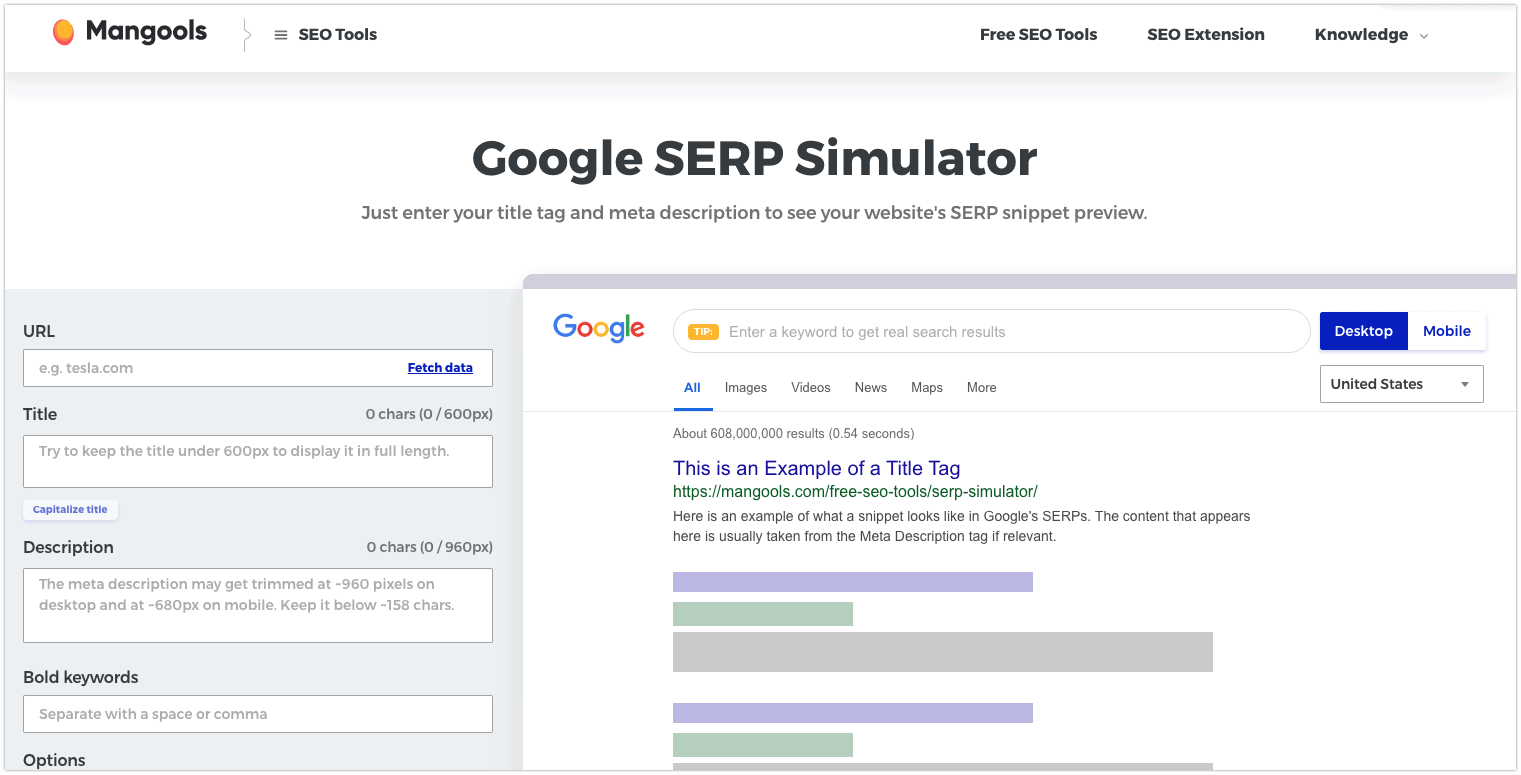
4. Add internal links.
Internal links are an important way to spread ranking power around your site.
So this final tip is simple:
Whenever you revamp an old article, try to link back to it from at least one of your newer articles.
That will help your older work start ranking well again.
Email New Content to Your Subscribers
Email is one of the best content distribution channels, period.
Your email list gives you a direct line to your audience. While your brand page’s social posts are only visible to about 2.2% of your followers on Facebook, 5.3% of them on LinkedIn, and 9.4% of them on Instagram.
Plus, your email subscribers can’t be taken away from you overnight. (Unlike your social followers.)
Finally, your biggest fans subscribe to your list. And they’ll often help spread the word when you publish something new.
So email is amazing.
When you publish new content, promoting it to your email list is a no-brainer.
There’s just one problem:
Getting email subscribers.
We’ll get back to that in a second. First, let me show you how I distribute new blog posts to my email list.
This easy method gets me open rates of around 40%.

The main guideline I have is to keep my emails simple.
I used to spend a lot of time crafting the perfect email. I’d introduce the subject to warm people up, include a good image from the post, and really pitch them on why they should click through.
But I learned that none of that is necessary. In fact, I get a much better response when I keep the emails super short.
That means:
- Plain text without images or fancy formatting.
- Brief email body that describes and links to the blog post.
- Very short email subject line.
Here’s an example:

It’s also important to avoid spam words and other spam triggers.
Otherwise, no one will even see your emails.
Now let’s look at how to get more email subscribers.
Build Your Email List
Like we talked about, email is an amazing content distribution channel.
(Not to mention a great way to actually sell to your customers.)
But of course, to do any email marketing you’ll need subscribers.
Here are 2 great ways to build your email list:
#1: Offer a great lead magnet.
Which one is more convincing?
“Subscribe to my email newsletter!”
Or:
“Get ___ for free!”
It’s the second one, right? Even without knowing what the free thing is.
Lead magnets work by offering people something specific in return for their email address. Giving visitors an immediate reason to subscribe.
That might mean a downloadable PDF or whitepaper, access to “gated” content, an invitation to a private Slack community, access to a free tool, entry into a video course or email-based course, a free webinar training, or a discount code.
(In fact, browse around HubSpot’s site for just a few minutes and you’ll spot most of those things.)
So you have lots of options.
Personally, I keep it simple. I like to take a high-value blog post and turn it into a PDF report. That way I know it’s something valuable… but it doesn’t take too long to make.
I recommend hiring someone on 99designs, Upwork or Fiverr to do this for you. You can get a professional-looking PDF with a nice cover image for under $50.
This one cost less than $20:

You can also create your own PDFs for free, right from your web browser. They just won’t look as good.
To do it that way, just go to your blog post and hit File >> Print in your browser.
Then choose the option to save it as a PDF.

You can create as many of these as you like.
On the GrowthBadger site, I offer the same PDF report in lots of different places.
On the homepage:

…As a “content upgrade” in the blog post the PDF is based on…

And in an exit-intent popup that most visitors see:
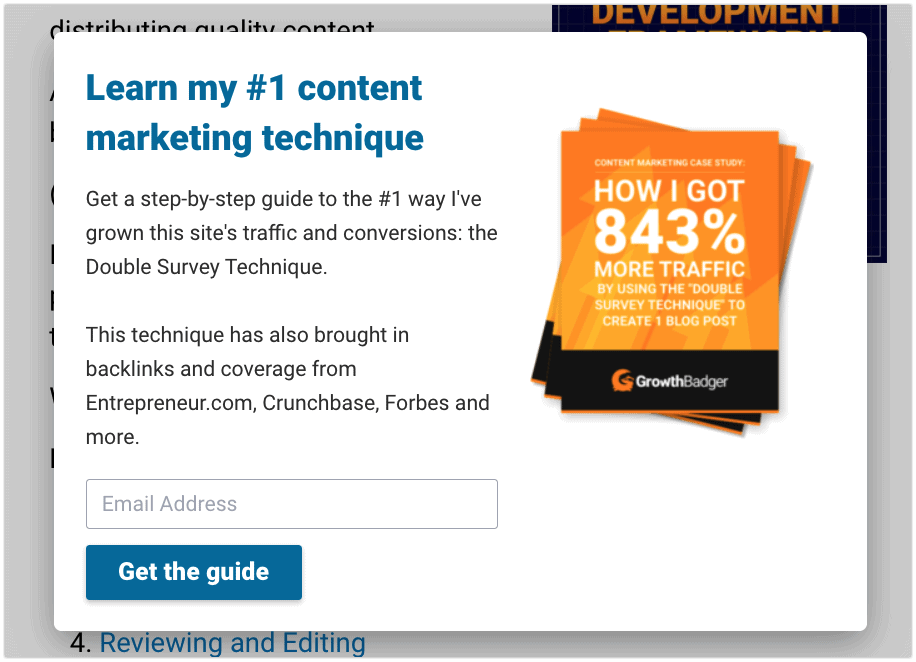
Which brings me to my next tip on building your email list…
#2: Use exit-intent popups.
Exit-intent popups are the most effective lead capture forms right now.
They work well because people pay attention to them.
But at the same time, exit-intent popups don’t interrupt people who are busy on your site. Which is critical.
Many email service providers come with exit-intent popup features. ConvertKit and Drip both do, for example. But if your ESP doesn’t offer them, you can try standalone popup software like RightMessage or OptinMonster.
As you set up your popups, there are 2 keys to keep in mind:
Key 1: Offer a lead magnet.
Okay, I know I’m beating a dead horse here.
But it’s crazy how many exit-intent popups don’t give people a reason to subscribe. So make sure you offer your lead magnet in yours.
As you saw above, I offer a PDF download as my lead magnet.
While Brooks Brothers uses a 15% off discount coupon as theirs:

The important thing is to use something as your lead magnet that most of your visitors will be interested in.
You can also change it based on context. (In other words, you can offer a different lead magnet based on the webpage they’re on.)
Key 2: Limit pop-ups for return visitors.
We’ve all been to websites that show you the same pop-ups over and over again.
Sometimes even to people who have already subscribed.
Don’t do that.
Instead, set your exit-intent pop-ups to only display to people once every 2-3 months. And ideally, don’t show them to existing subscribers at all.
Use a “Greatest Hits” Welcome Email
When someone subscribes to your email list, don’t just send a confirmation email and leave it at that.
They subscribed to see more of your stuff. So why wait until your next piece of content comes out? Show them your best work right away.
Here’s an example from Aleyda Solis’s #SEOFOMO email newsletter:

And if you have a SaaS business, your welcome email is a great place to point new users to your how-to content.
Like “getting started” video tutorials, your setup guide or FAQ.
Here’s how Frase does this in their welcome email:

Add Social Follow (or Share) Prompts To Your Thank-You Page
Here’s how you can get extra value from each new user, customer, or email subscriber:
After someone signs up or makes a purchase, simply ask them to follow you or spread the word.
You can also use the free tool GoViral to offer an incentive.
GoViral will prompt people to share your content on Facebook, Twitter, LinkedIn or elsewhere. Offering them a bonus PDF download if they do.

Do a Lead Magnet Swap
When GrowthBadger was first getting started, I ran several “lead magnet swaps” with other bloggers who wrote about related marketing topics.
One had a blog about copywriting.
One had a blog about blogging and podcasting.
And one had a blog about email marketing.
None of them had millions of subscribers. But each time I did a swap, I got a decent little bump in signups.
Plus, each partnership started a new relationship with a fellow creator in my space.
Here’s how these lead magnet swaps (also called guest email swaps) work:
First, email your pitch to someone who has an email list of people you’d like to reach. Best if their audience is similar to yours, but they aren’t directly competing with you.
For a little social proof, let them know how many subscribers you have. And maybe your average open rate.
You can increase your response rate by leaving great comments on their blog or social posts in the week or so beforehand, so they’ll recognize your name on the email.
Here’s one of the pitches I made:

If they agree, the next step is to agree on the specifics:
- What to promote
- When to do it
- How to phrase it
Then, you’ll send your list an email with a link to your partner’s best lead magnet — on their site. So people need to sign up to your partner’s email list in order to get it.
And of course, your partner does the same for you.
Here’s a lead magnet swap email I sent:
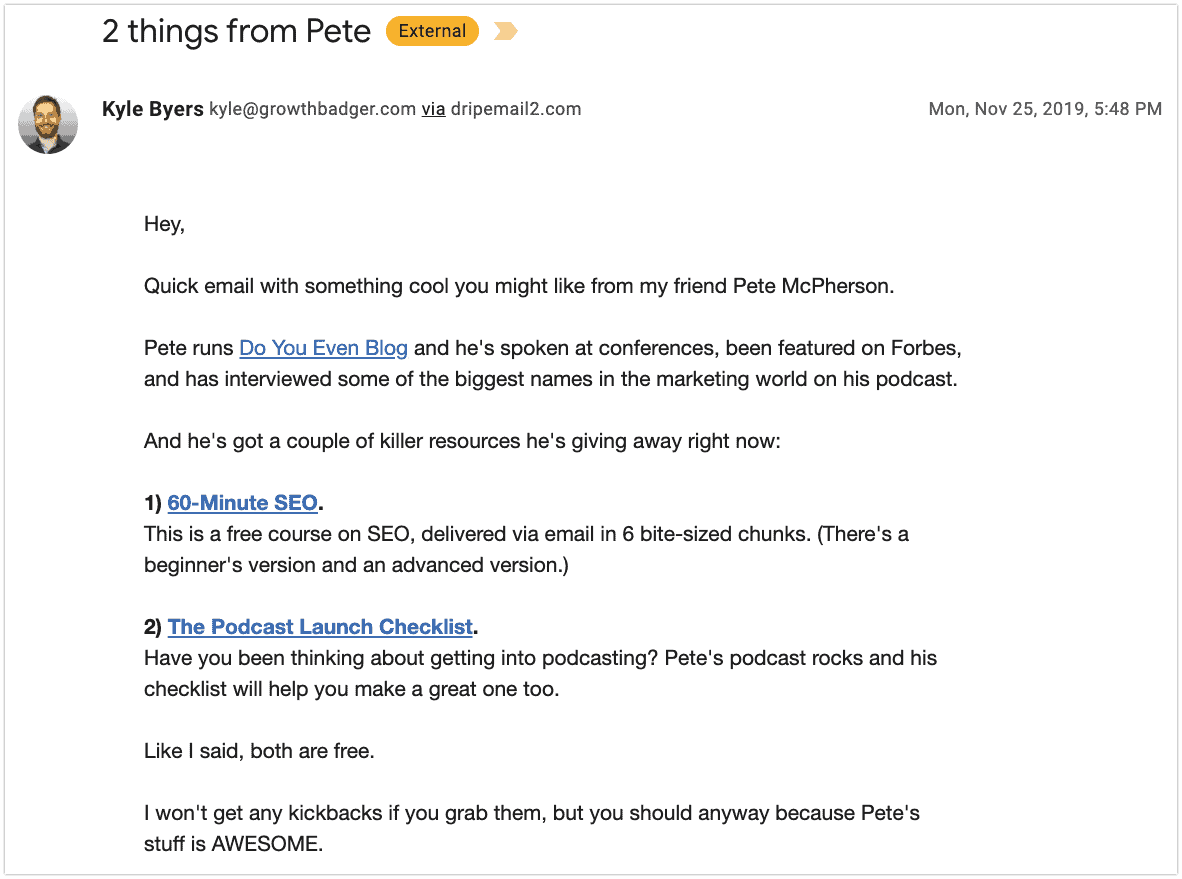
That’s it!
These types of co-promotions can be a great way to grow your reach.
Like I said, the key is to find people who aren’t in direct competition with you. But who share similar audiences.
For example, my focus is on content marketing.
I teach business owners and marketers how to get more traffic and customers with content marketing.
That’s why I partnered with a copywriter, a podcaster and an email marketer: I knew my stuff would be useful to their audiences. Without actually competing with any of them.
Submit to Link Roundups
This is an old-school content distribution technique.
But it’s also pretty low-effort.
It just takes 2 steps:
Step 1: search Google for link roundups in your industry.
Try phrases like:
“[subject] links”
“This week’s best [subject] articles”
“This month’s best [subject] content”
And “Favorite [subject] articles”.
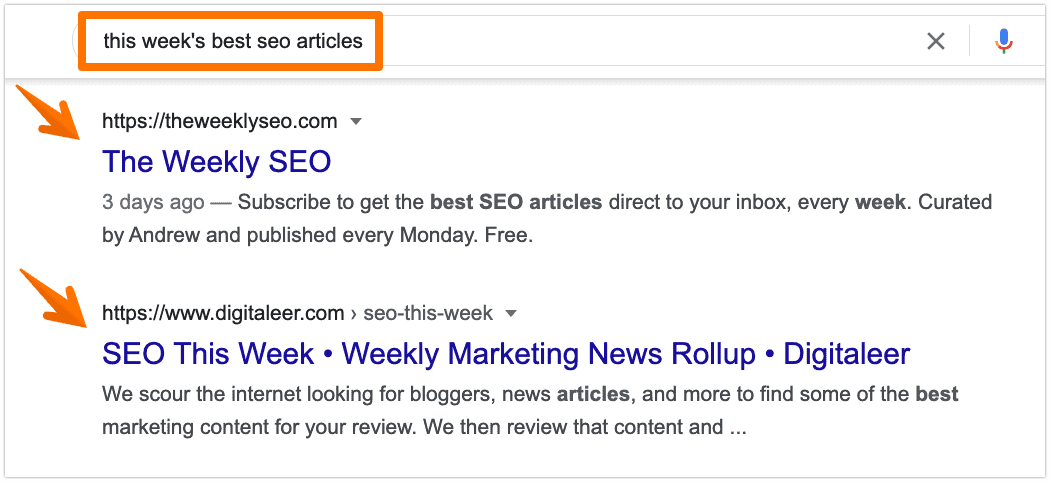
Step 2: submit your new content.
Now look for where you can submit your content for inclusion in the next roundup.
Often, there will be a form like this:

If there isn’t a form, email the person who runs the roundup.
Not sure how to reach them?
Subscribe to the site’s email list and then respond to the first email you get. Or use Hunter.io to find the owner’s contact info.
Get Featured in Email Newsletters
There aren’t as many link-roundups now as there used to be.
But there are tons of email newsletters. Lots of which curate other people’s content.
Like the 5-Bullet Friday by Tim Ferriss, and the 3-2-1 Thursday newsletter by James Clear.
Of course, those newsletters are huge.
You don’t have much of a chance with them because they get pitched all the time.
Instead, reach out to smaller, niche newsletters. And your odds of getting featured will skyrocket.
And because those newsletters are more focused, you can be sure their audiences are relevant to your business.
For example:
The Moz Top 10 is a leading email newsletter in the SEO and content marketing space. But when my content marketing examples post got featured at the top of one issue, it actually didn’t bring in all that much traffic.
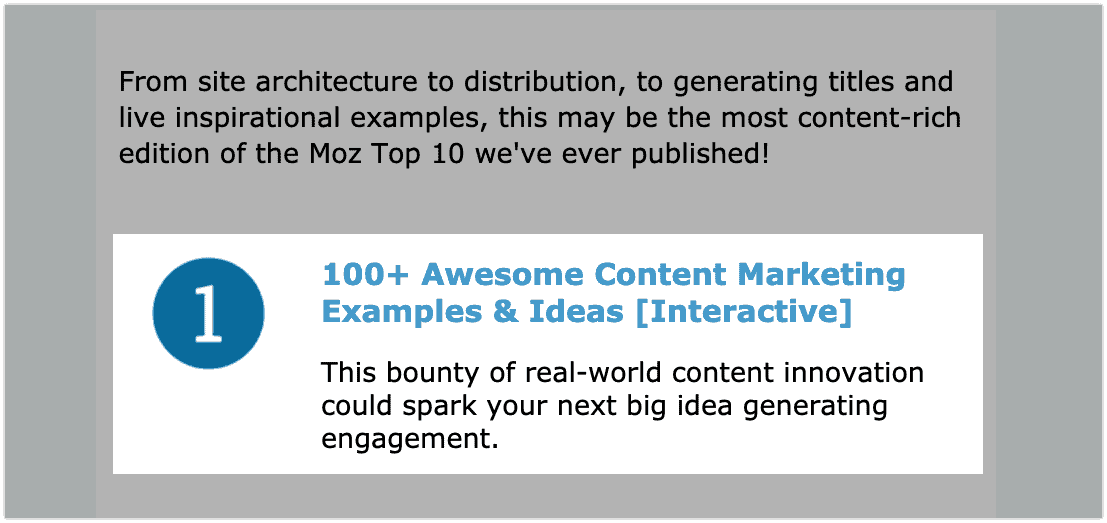
However, the visitors from that newsletter converted to subscribers really well. (And I’m pretty sure getting featured helped earn me some great backlinks, too.)
Now here’s how to find great newsletters in your niche.
One way is to just Google it:
Try “[subject] email newsletters” or “best [industry] newsletters”.
But if you’re just getting started, you might need even smaller options. Here’s how to find those.
First, go to substack.com/discover.
Type in your topic. (For example, “marketing” or “content marketing”.)
Then hit enter.
You’ll see a list of Substack newsletters on that topic. Along with the author name, description of the newsletter, and how old it is.
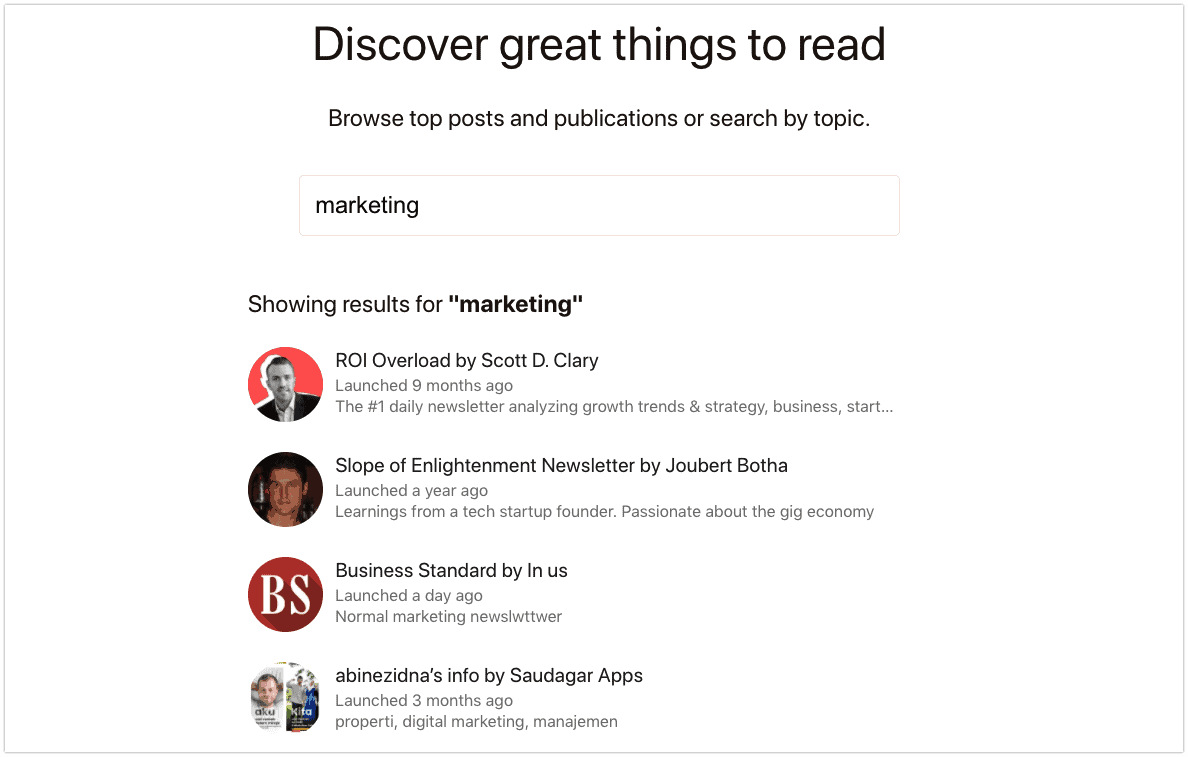
Click on any newsletters that look relevant, then click “Let me read it first” to see past issues.
Look at the engagement numbers to get a sense of how popular they are. If you’re seeing all 0s, move on.
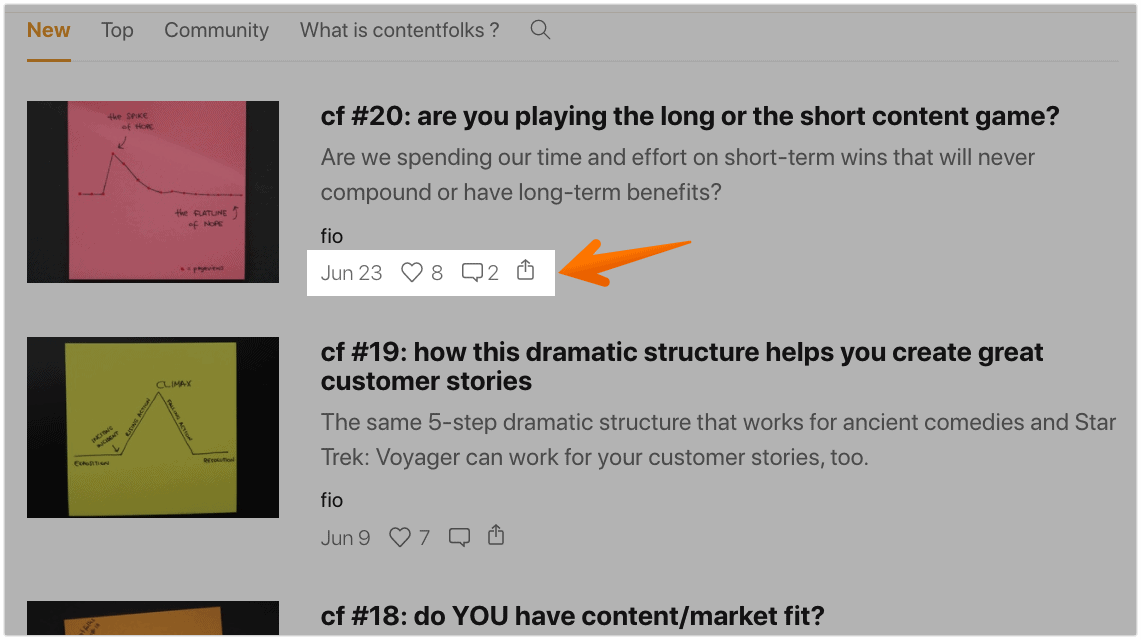
Then, look at an issue or two to see whether your content might be a good fit for them to write about.
If the newsletter looks like a good fit, subscribe.
And finally, when you have a new piece of content, reply to the latest newsletter issue to let them know what you published and why they might like it.
For even more newsletters, you can repeat this process on Revue using Revue Discover.
And to increase your odds of success with a given newsletter, create a connection with its writer first by leaving some valuable comments. More on that in the next tip below.
Reach Out to Influencers
Influencer outreach is one of the most tried-and-true content distribution techniques.
But the old “spray and pray” method doesn’t work anymore. There are too many spammers.
So you have to be more strategic about it now.
There are 2 keys to making influencer outreach work:
Be smart about who you reach out to. And build a relationship first.
Key #1: Be smart about who you reach out to.
It’s critical to reach out only to relevant people who are already sharing content in your niche.
BuzzSumo is a huge help here.
Just click over to the “Influencers” tab at the top.
Then type in your topic or keyword below.
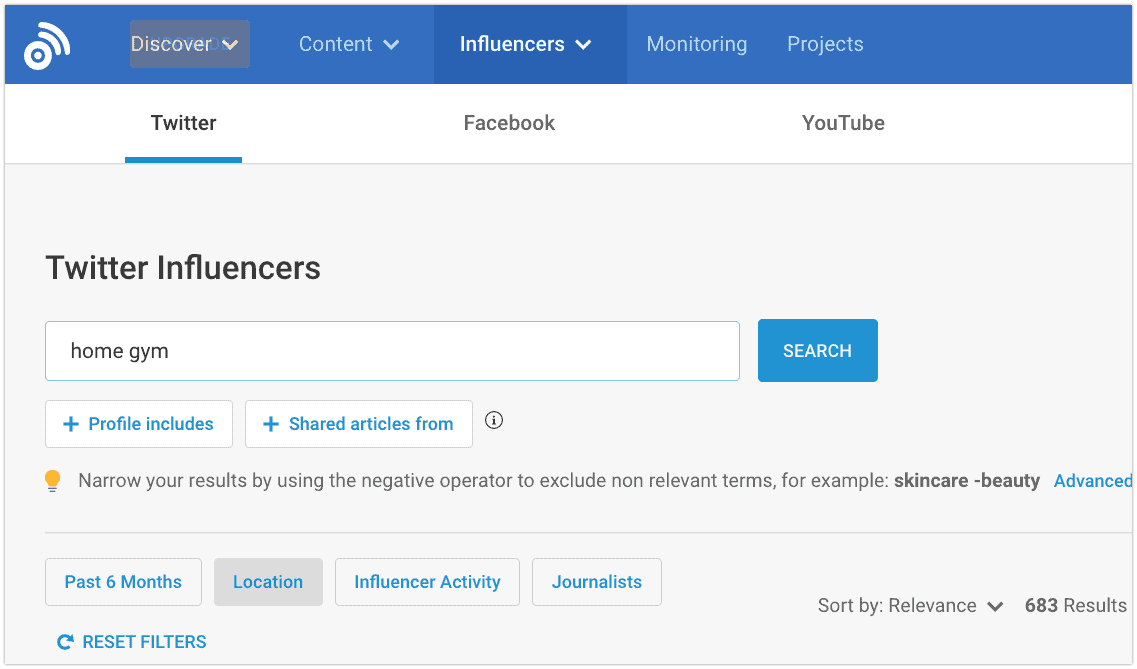
Then hit “search” and BuzzSumo will pull up a list of accounts that recently shared content about that topic.
Now you have a list of people who should be eager to share your content. (Assuming it’s high quality, of course.)
Key #2 is: Build relationships first.
Influencers are constantly getting spammed with requests to share or link to different things. So if you reach out to them cold, your email is usually just going to get deleted.
Instead, put in a little elbow grease.
Rather than spamming everyone you find, establish a relationship first with a smaller number of them.
Leave genuinely valuable comments on their posts. Retweet them. Get involved in their community.
Once you’ve established some rapport, then you can occasionally ask them for a share.
(Or just ask for their feedback — and they’ll often share your content naturally.)
A side benefit to taking this route is that you’ll make some real friends in the process. Aww.
Click to Tweet
Click to Tweet is a free tool that does what it sounds like:
It lets you create links that people can click on to quickly tweet a quote from your content.
Here it is in action on Ryan Robinson’s blog:

Clicking that button opens up this ready-to-send tweet draft:
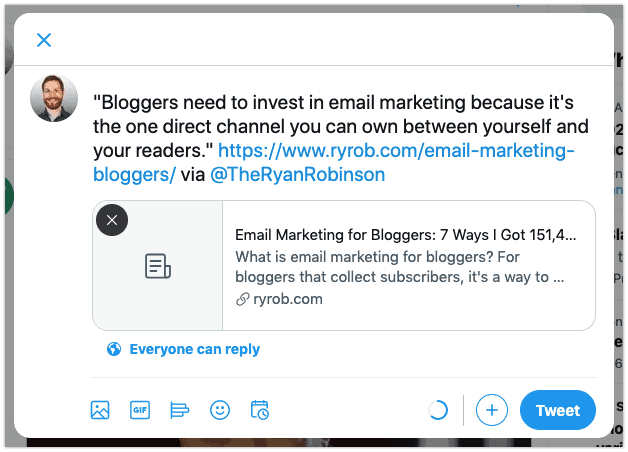
Ryan has these prompts sprinkled throughout most of his articles.
And as a result, people share his work on Twitter pretty much every day.
Find Content Distribution Opportunities in Google Analytics
When I first started GrowthBadger, I published lots of different types of content:
- Blog progress updates
- In-depth guides
- Quick tips
- Studies and data-driven content
After a while, I realized that 90% of my results were coming from my in-depth guides and studies.
So I started focusing on those alone.
That made it so that each time I published a new post, my site visits would shoot up by 5x-10x for a few days. And even after that spike cooled off, my new baseline of traffic would stay higher than before.
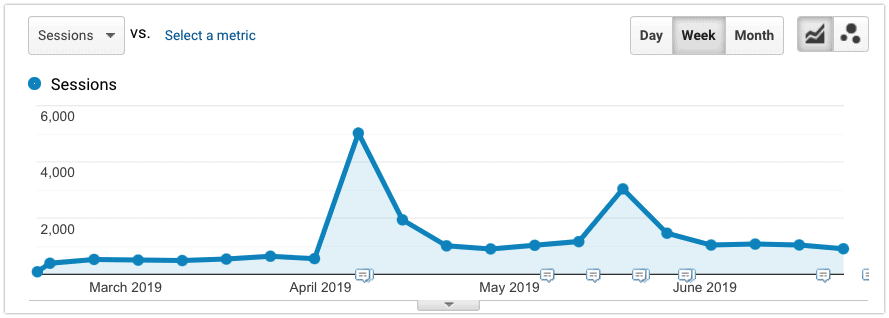
Granted, those were still very small numbers.
But I was used to hearing nothing but crickets. So it was super exciting to finally figure out a way to grow my blog. And all it took was doubling down on something I’d already tried.
As content marketers, our success relies on figuring out what works…
And doing more of that.
The 80/20 rule applies to every site I’ve ever seen.
So I can pretty much guarantee that at least 80% of your results are coming from 20% of your efforts.
Here’s how to use Google Analytics to find your best traffic sources. That way, you can focus more on the content distribution channels that are already working.
How to see your best traffic sources:
Check out the All Traffic report. In the left-hand menu, go to Acquisition >> All Traffic >> Source/Medium.
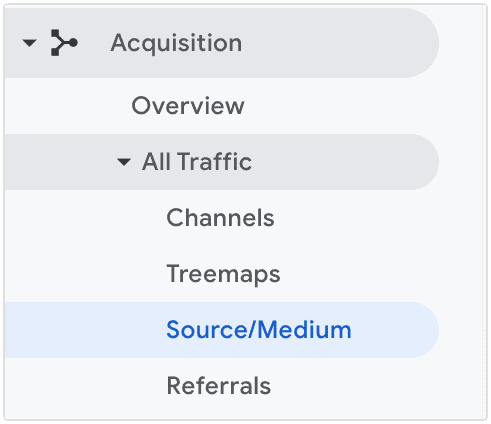
This will pull up a report of all your traffic sources.
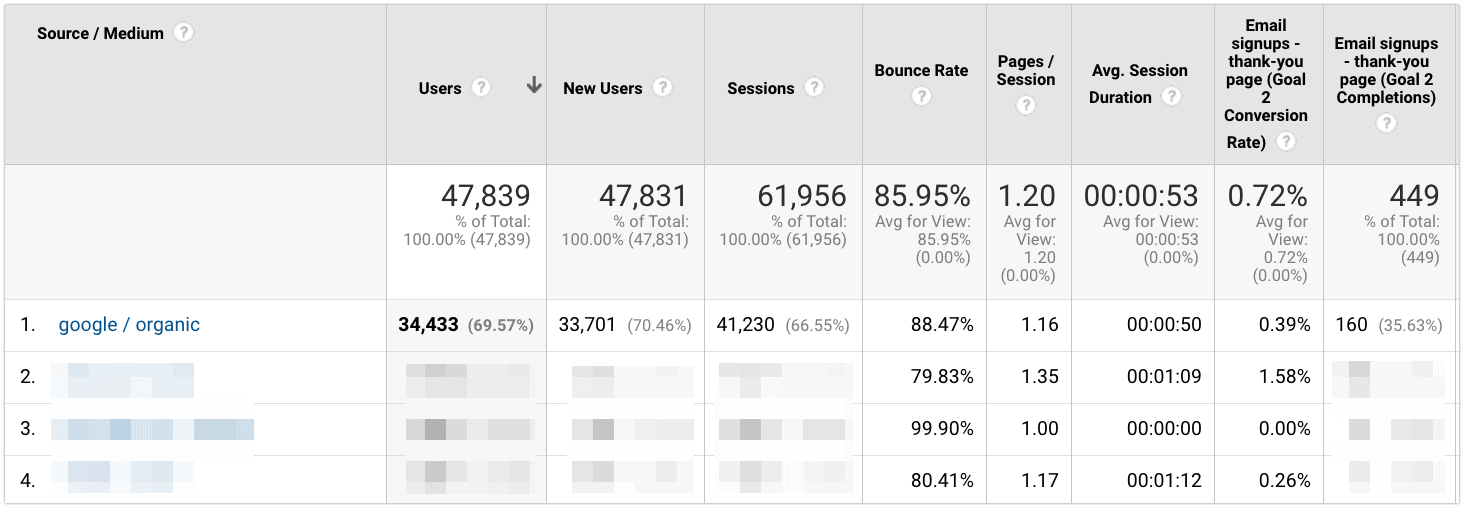
But don’t just look at the number of sessions. That’s not the most important metric (unless you’re monetizing with ads).
Instead, scroll to the right to see how many conversions you’re getting from each traffic source. For example, the number of purchases or signups.
(Here’s how to set up conversion goals if you haven’t yet.)
Now you know where your best traffic is coming from. So you can put more effort into those sources.
Note:
You can go as deep as you want with this analysis.
If most of your conversions are coming from social media, there’s probably one network that’s driving 80% of that. Can you double down on that social network?
You can also use Google Analytics to see your top-performing pieces of content.
To see which types of content are working best for you, check out the Landing Pages report.
You can get to it via Behavior >> Site Content >> Landing Pages.
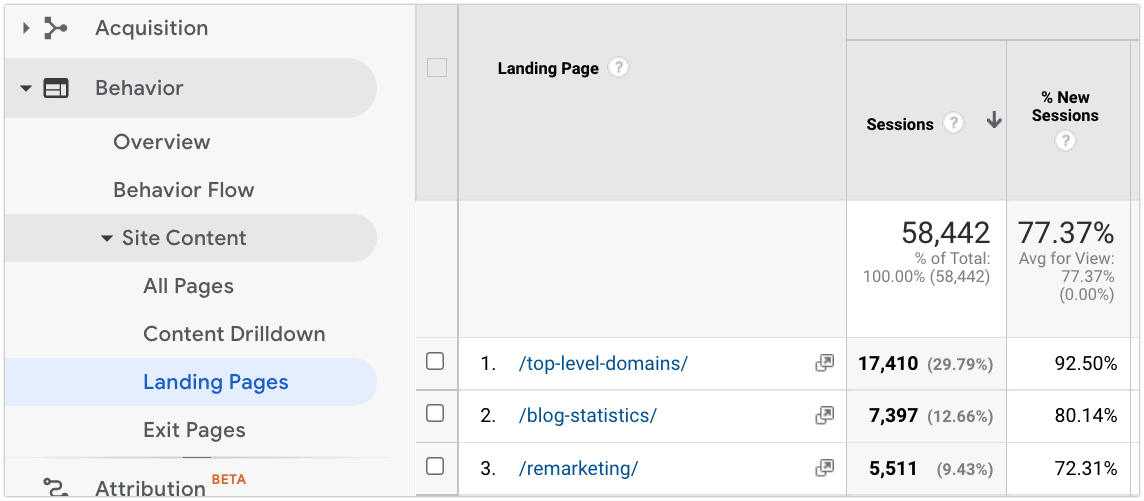
Again, scroll to the right to see conversions.
What patterns do those pieces of content share? How about the content promotion tactics you used for them?
Join Growing Social Networks Early
It’s hard to stand out on social media. The biggest social networks are filled with people promoting their content and interacting.
But on newer platforms, there’s much less competition. Which can allow you to get traction before everyone else shows up to the party.
Take TikTok, for example.
The people who joined TikTok early had time to figure out what worked best on the platform.
And to build up decent followings.
Like most social networks, TikTok recommends popular, growing accounts. Those recommendations give those accounts a huge tailwind, making them even more popular.
So as TikTok grew from nothing in 2016 to over 1 billion users today, its early adopters reaped massive rewards.
It’s too late to be early on TikTok. But there are plenty of newer social networks that still offer that opportunity.
For example:
As I write this, Clubhouse only has about 10 million active users.
BitClout has under 1 million.
And Racket only has about 10,000.
Of course, any of those could shut down at any moment. That’s the risk of joining early.
But at least one or two will probably survive. And the people and businesses who are building a presence there now will be rewarded for it.
Use Medium.com
Republishing your articles on Medium.com is a great way to get them in front of more people.
That’s because when you publish something on Medium, it has a chance to get recommended to anyone reading any other article on Medium.
Naturally, this also increases its chances of going viral.
Best of all?
Medium has a built-in canonical feature. This inserts a rel=”canonical” tag on your Medium post, which tells Google that it isn’t the original version. And that the version that’s on your site is the original instead.
That way you won’t be competing with yourself for search traffic.
To republish your content on Medium, go to Stories and then click “Import a story.”

Next, add the URL of your article. And hit “Import.”
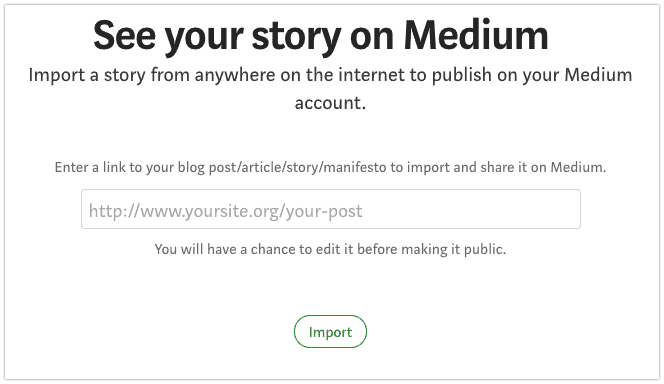
Medium will import your blog post and let you make any edits you want. And when you publish it, it will have the rel=”canonical” tag pointing back to the original.
Nice!
You can also write for other publications on Medium.
Most publications won’t let you republish content you’ve already posted elsewhere. But if you can write an original piece, you’ll be able to reach a wider audience by piggybacking on their reach.
For example, Start It Up has an impressive 10 million monthly readers. And they’re always accepting submissions from new writers.
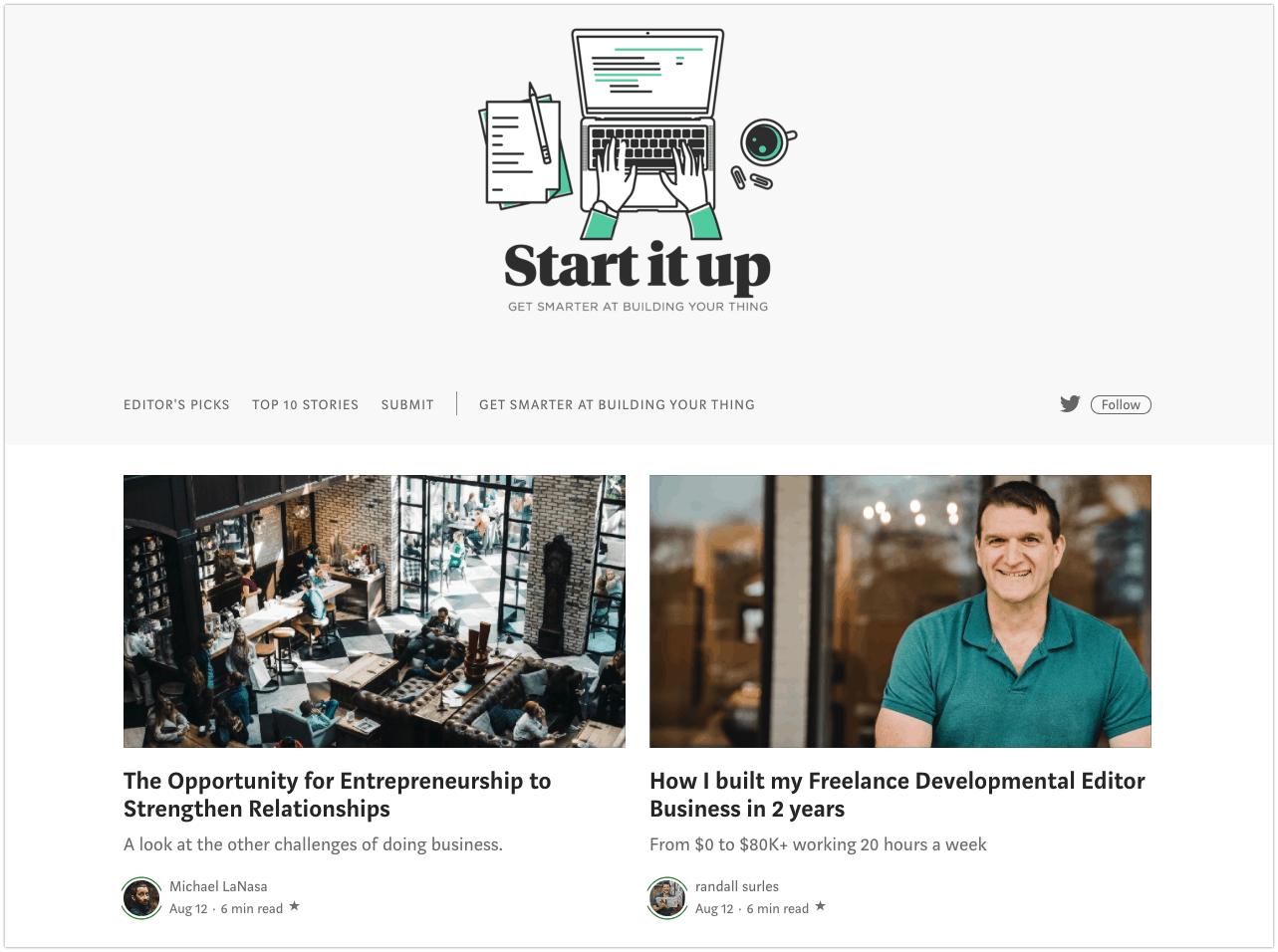
(And unlike traditional guest posting, you can even get paid to write for them.)
Share Your Content on Social Media
This one is obvious. But most people screw it up.
(Or don’t do it at all.)
Facebook, Instagram, Twitter, Snapchat, LinkedIn, Pinterest, TikTok… any social media account you have, share your content there.
Just follow one rule:
Provide plenty of value up front.
Meaning, make your social posts interesting enough that people will engage with and share them — even if they don’t click through to your actual content.
In other words, don’t just share a “naked” link.
My favorite way to provide value up front is via a summary of key points. But you can also just talk about one specific tidbit from the content you’re sharing.
As long as what you post is good enough on its own for people to comment on, right then and there.
After all, that’s how people with lots of followers share things “in the wild.”
Here’s an example:

Here are a few more tips for content distribution on social media:
- Tag anyone you linked to, referenced or quoted in your content. They’ll often share it in response.
- Use social meta tags. You can control the title, description and image that are displayed when people share your content on social. The two major tag types are Open Graphmeta tags (“OG” meta tags) and Twitter meta tags.
- Match your message to the medium. Like I said earlier, it’s super important to make your format and style fit the platform you’re posting on. That’s even true for different post types on the same network: for example, Instagram posts, Stories, Reels and IGTV all require different types of content.
LinkedIn has over 770 million users worldwide.
And it’s unique among social networks in one way: it’s focused on professionals.
That makes LinkedIn the perfect channel for B2B content distribution.
Luckily, the network gives you plenty of ways to show off your work.

Here are 5 ways to distribute content on LinkedIn.
- Participate in relevant LinkedIn Groups. Did you know that there are over 2,000,000 LinkedIn Groups? Your target audience is almost certainly in a few of them. Join any relevant groups, and take part in the discussions in them. And naturally sprinkle in references to your content where possible.
- Post updates. Hands down, regular LinkedIn posts are the most common content distribution technique on the platform. Any time you publish a new piece of content, just write a brief (but enticing) post that links back to it. Simple.
- Publish LinkedIn Articles (LinkedIn Pulse). Regular Linkedin posts can only be up to 3,000 characters long. But for longer-form content, LinkedIn also lets you publish articles. These are public, Google-indexed blog posts that are hosted by LinkedIn. Which means you can take any blog posts you’ve already published on your site and re-publish them on LinkedIn — either in full, or in part (with a link back to the original).
- Post videos. LinkedIn also lets you post videos or video excerpts. If you’re already making videos, why not take advantage?
- Use LinkedIn Creator Mode. LinkedIn has finally figured out that not everyone on the platform is looking for a job or hiring. “Creator Mode” is their solution. When you switch Creator Mode on, it prompts people to follow you instead of connect with you. And it changes the layout of your LinkedIn profile to prioritize your activity, with extra focus on your recent content.
Use SlideShare for B2B Content Distribution
SlideShare isn’t as powerful as it used to be. But it’s still a great place to cross-post free content. Especially B2B, data-driven content.
For example, the Digital 2021 Global Overview Report slide deck by We Are Social was viewed nearly 900,000 times in the first 5 months after it was published.
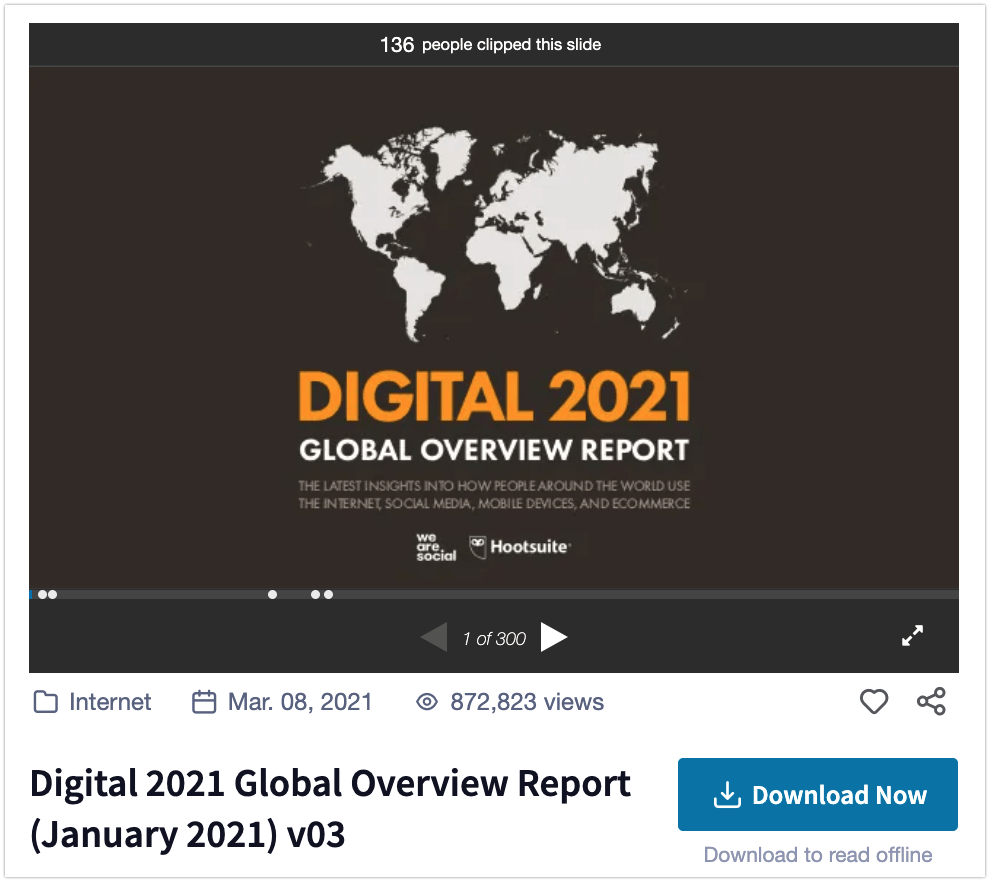
That deck is basically just a SlideShare version of a report that We Are Social was already making anyway.
The company created the SlideShare deck and embedded it into a blog post on their own website with additional details. Which has helped that blog post attract backlinks from over 500 other sites, including Columbia University, McAfee and Hacker Noon.
Share Your Slide Deck as an Instagram Carousel
Once you’ve made a presentation deck for SlideShare, why not distribute it on Instagram too?
Instagram carousels let you package up to 10 images into a single post. That’s perfect for an entire short presentation, or an excerpt from a longer one.
Here’s an example of how Buffer published the first handful of slides from its 2021 State of Remote Work report. Notice how the full report’s URL is shown at the bottom of each image:
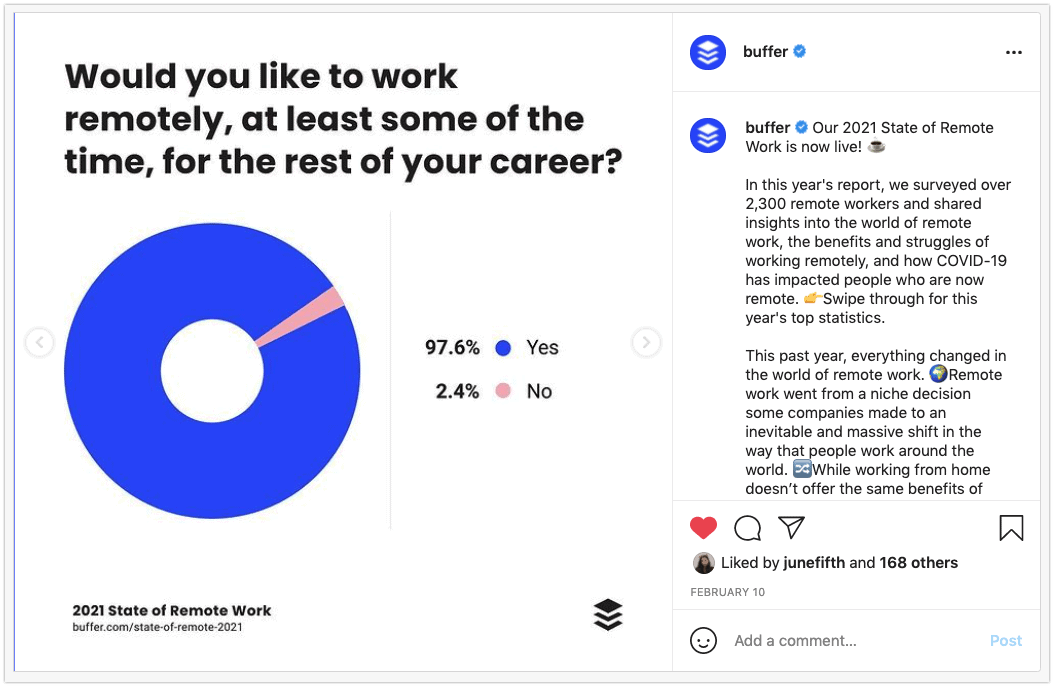
Conclusion
And there you have it: the complete guide to content distribution.
What did you think?
Are you going to try any of these content distribution ideas?
Maybe you haven’t tried promoting your content on Reddit before. Or using paid ads to drive more traffic to your content marketing assets.
Or is there another technique I should add to the list?
Let me know in the comments below. I read every one.

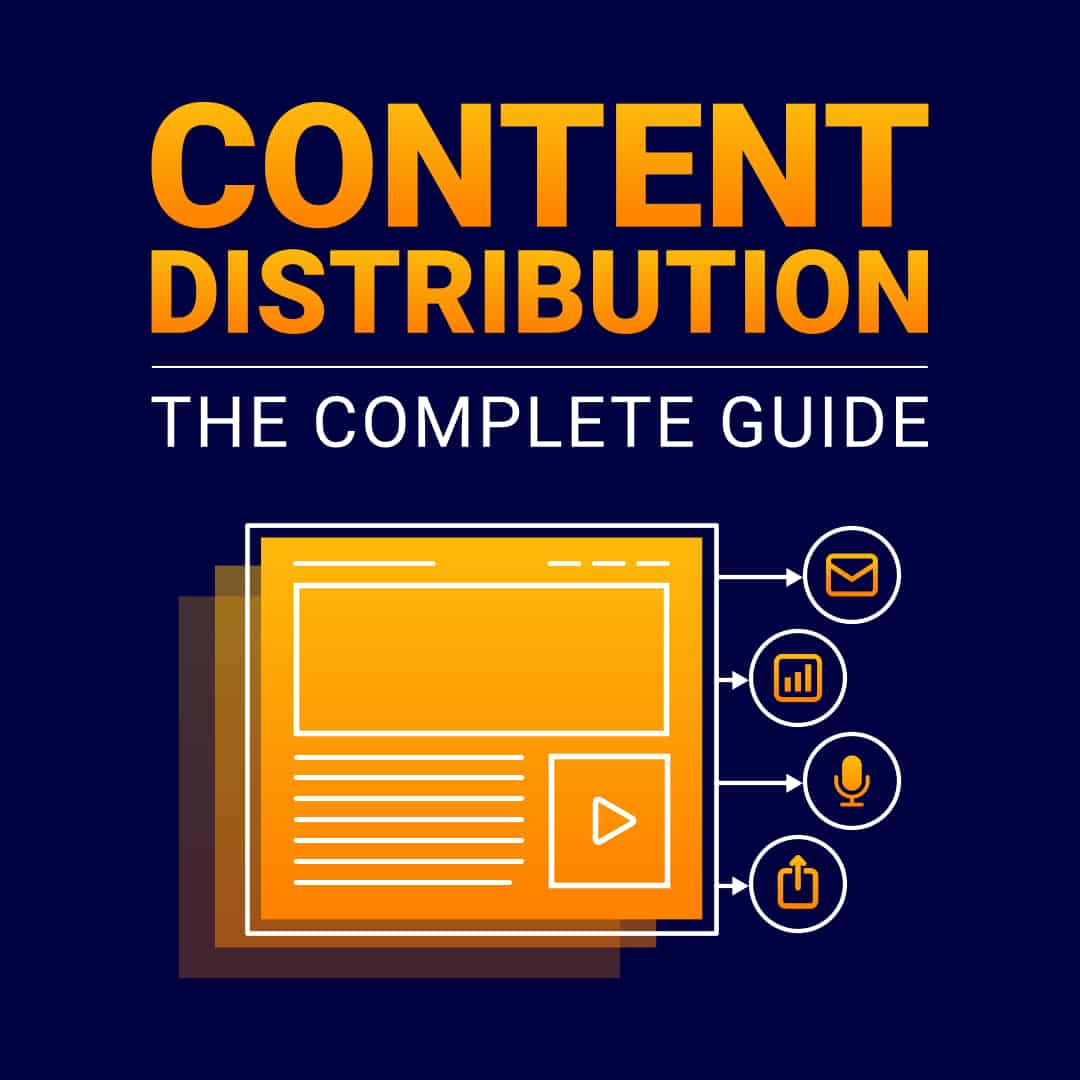
Hi Kyle
Excellent post and I’m really glad I opened it on my email (nearly skimmed and it would have been gone). Really like the Reddit and YouTube sections. Plant a seed on the platform and offer the full answer on the site.
Additionally and most importantly, keeping it relevant to the platform you are using. Agree that it easy to go all guns blazing everywhere and not hit a thing. I’ve done it….
Thanks for a great, easy on the eye and informative post.
Daniel